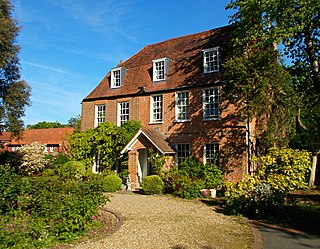
Cheam is a commuter suburb now in the London Borough of Sutton, England, 10.9 miles (17.5 km) south-west of Charing Cross. It divides into North Cheam, Cheam Village and South Cheam. Cheam Village contains the listed buildings Lumley Chapel and the 16th-century Whitehall. It is adjacent to two large parks, Nonsuch Park and Cheam Park. Nonsuch Park contains the listed Nonsuch Mansion. Parts of Cheam Park and Cheam Village are in a conservation area. Cheam is bordered by Worcester Park to the north-west, Morden to the north-east, Sutton to the east, Ewell to the west and Banstead and Belmont to the south.

Penshurst is a historic village and civil parish located in a valley upon the northern slopes of the Kentish Weald, at the confluence of the River Medway and the River Eden, within the Sevenoaks district of Kent, England.
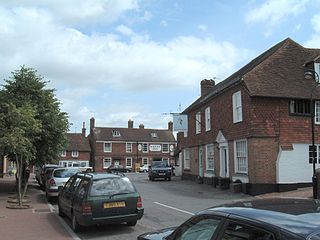
Rotherfield is a village and civil parish in the Wealden District of East Sussex, England. It is one of the largest parishes in East Sussex. There are three villages in the parish: Rotherfield, Mark Cross and Eridge. The River Rother, which drains much of the county and discharges at Rye Harbour, has its source on the south side of the hill on which Rotherfield village is built.

Rusthall is a village located approximately 2 miles to the west of the spa town of Tunbridge Wells in Kent. The village grew up around a large property called "Rusthall" located on Rusthall Common.

St Mary the Virgin is a Church of England parish church in Henbury, Bristol, England.
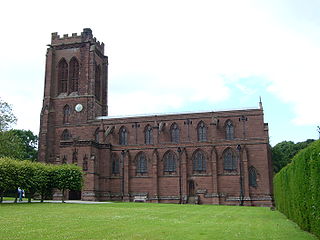
St Mary's Church is in the village of Eccleston, Cheshire, England, on the estate of the Duke of Westminster south of Chester. The church is recorded in the National Heritage List for England as a designated Grade I listed building. It is an active Anglican parish church in the diocese of Chester, the archdeaconry of Chester and the deanery of Chester. Its benefice is combined with that of St Mary, Pulford. The Dukes of Westminster are buried in the adjacent Old Churchyard.
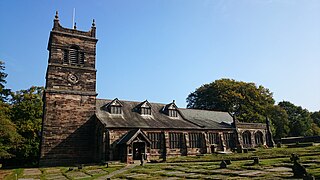
St Mary's Church lies between the village of Rostherne and Rostherne Mere in Cheshire, England. The church is recorded in the National Heritage List for England as a designated Grade I listed building. It is an active Anglican parish church in the diocese of Chester, the archdeaconry of Macclesfield and the deanery of Knutsford. Its benefice is united with that of Holy Trinity, Bollington.

St Helen's Church is in the village of Tarporley, Cheshire, England. It is an active Anglican parish church in the diocese of Chester, the archdeaconry of Chester and the deanery of Malpas. Its benefice is united with those of St John and Holy Cross, Cotebrook, St Thomas, Eaton, and St Paul, Utkinton. The church is recorded in the National Heritage List for England as a designated Grade II* listed building.
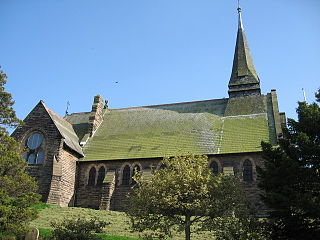
St Paul's Church is in the village of Helsby, Cheshire, England. The church is recorded in the National Heritage List for England as a designated Grade II listed building, and is an active Anglican parish church in the diocese of Chester, the archdeaconry of Chester and the deanery of Frodsham. Its benefice is combined with that of St Luke, Dunham-on-the-Hill.

Wykeham Terrace is a row of 12 early 19th-century houses in central Brighton, part of the English city of Brighton and Hove. The Tudor-Gothic building, attributed to prominent local architect Amon Henry Wilds, is built into the hillside below the churchyard of Brighton's ancient parish church. Uses since its completion in 1830 have included a home for former prostitutes and a base for the Territorial Army, but the terrace is now exclusively residential again. Its "charming" architecture is unusual in Brighton, whose 19th-century buildings are predominantly in the Regency style. English Heritage has listed the terrace at Grade II for its architectural and historical importance.

The English coastal city of Brighton and Hove, made up of the formerly separate Boroughs of Brighton and Hove in East Sussex, has a wide range of cemeteries throughout its urban area. Many were established in the mid-19th century, a time in which the Victorian "cult of death" encouraged extravagant, expensive memorials set in carefully cultivated landscapes which were even recommended as tourist attractions. Some of the largest, such as the Extra Mural Cemetery and the Brighton and Preston Cemetery, were set in particularly impressive natural landscapes. Brighton and Hove City Council, the local authority responsible for public services in the city, manages seven cemeteries, one of which also has the city's main crematorium. An eighth cemetery and a second crematorium are owned by a private company. Many cemeteries are full and no longer accept new burials. The council maintains administrative offices and a mortuary at the Woodvale Cemetery, and employs a coroner and support staff.

St Anne's Church is an Anglican church in St Anne's-on-the-Sea, a town on the Fylde coastal plain in Lancashire, England. It is an active Church of England parish church in the Diocese of Blackburn and the archdeaconry of Lancaster. It is recorded in the National Heritage List for England as a designated Grade II listed building.

St Lawrence's Church is an Anglican parish church at Mereworth, Kent, United Kingdom. It is in the deanery of West Malling, the Diocese of Rochester and Province of Canterbury. The church was built in the mid-1740s by John Fane, the 7th Earl of Westmorland, following his removal of the village's 12th century place of worship to allow for the enlargement of Mereworth Castle.
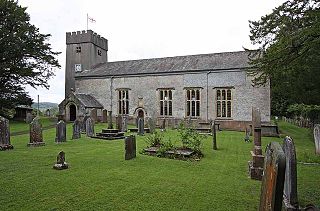
St Paul's Church is in the village of Witherslack, Cumbria, England. It is an active Anglican parish church in the deanery of Kendal, the archdeaconry of Westmorland and Furness, and the diocese of Carlisle. It is recorded in the National Heritage List for England as a designated Grade II* listed building. The authors of the Buildings of England series describe it as "an almost perfect example of a plain Gothic church of that date, honest and unpretentious".

St. Mark's Church is the Church of England parish church for the Broadwater Down area of Royal Tunbridge Wells, Kent, England, in the Diocese of Rochester. Built in the 19th-century Gothic Revival style by Robert Lewis Roumieu, it is a Grade II* listed building.
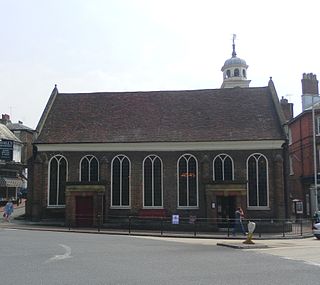
The Church of King Charles the Martyr is a Church of England parish church in Royal Tunbridge Wells, Kent, England. It is a Grade I listed building.

Holy Trinity Church is a Church of England parish church based in Crockham Hill, Kent, England. It was constructed in 1842 and is a Grade II listed building.

St Thomas of Canterbury Church, also known as St Thomas's, Rylston Road, is a Roman Catholic parish church in Fulham, central London. Designed in the Gothic Revival style by Augustus Pugin in 1847, the building is Grade II* listed with Historic England. It stands at 60 Rylston Road, Fulham, next to Pugin's Grade II listed presbytery and churchyard and St Thomas's primary school, also largely by Pugin, close to the junction with Lillie Road in the Borough of Hammersmith and Fulham.

Tunbridge Wells Town Hall is a municipal building in Mount Pleasant Road, Royal Tunbridge Wells, Kent, England. The town hall, which is the headquarters of Tunbridge Wells Borough Council, is a Grade II listed building.





















